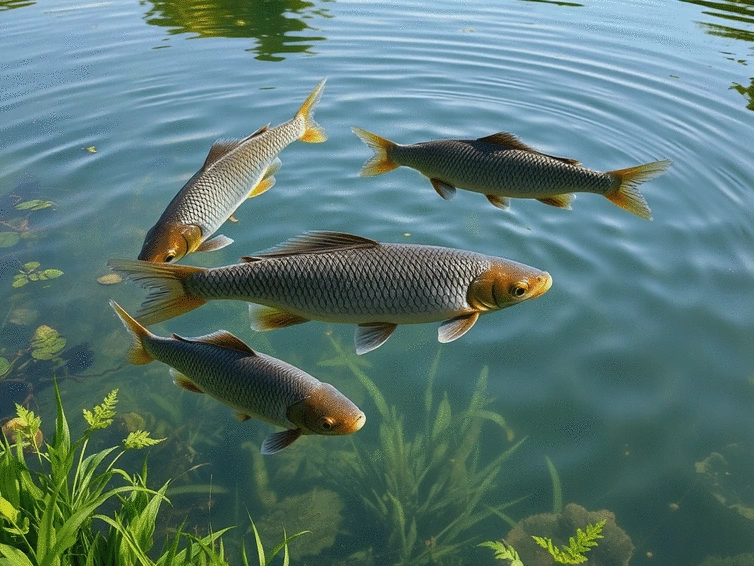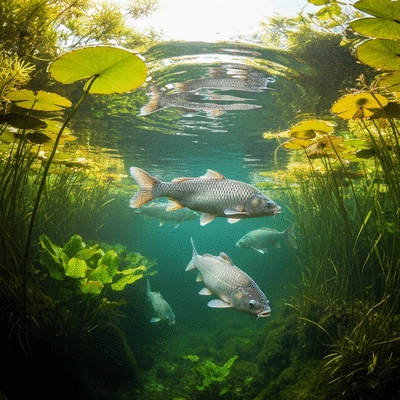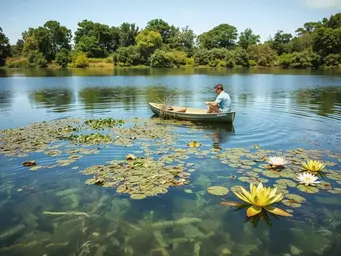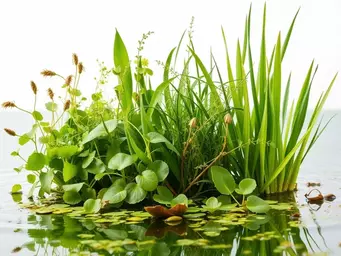Mechanisms of Weed Control
- Biological Grazing
- Disruption of Growth
- Maintenance of Biodiversity
Natural, sustainable biological control.

Have you ever wondered how a fish can significantly impact the health of our waterways? Grass carp may not just be another fish in the sea; they could be the key to a sustainable solution for aquatic weed control.
A visual comparison of the advantages and regulatory aspects of using grass carp for sustainable aquatic weed reduction.
Natural, sustainable biological control.
Cost-effective; reduces chemical dependency.
Supports healthier aquatic environments.
Compliance ensures ecosystem safety.
As we explore the fascinating world of aquatic ecosystems, it’s essential to understand the role of grass carp in managing aquatic weeds. These fish are not just a part of the food chain; they offer a natural solution for controlling the proliferation of invasive plant species that threaten our waterways. In this section, we’ll dive into their biology, behavior, and the significant contributions they make to sustainable aquatic weed reduction. For more information on their effectiveness, you can refer to insights from Wiley Online Library.

Grass carp are native to the rivers and lakes of East Asia but have been introduced to many regions globally for their exceptional weed control capabilities. They thrive in freshwater environments, where they can adapt to different water quality and temperature conditions. Understanding their natural habitat is crucial for effective management.
One of the most fascinating aspects of grass carp is their selective feeding behavior. They primarily consume aquatic vegetation, particularly submerged and floating plants. Their preferences include:
This selectivity makes them effective at targeting problematic species while preserving beneficial native plants. As an aquatic weed management specialist, I often highlight the importance of recognizing these preferences when planning their introduction into a waterway, as detailed by UAPB News.
Grass carp display unique behaviors that influence their effectiveness in weed control. They are typically social fish, moving in groups to graze on vegetation. As they grow, their appetite increases, and they can reach sizes of up to 40 inches and weigh over 100 pounds. This rapid growth can significantly impact aquatic ecosystems, especially when managed correctly.
Monitoring their growth patterns allows us to adjust management strategies and ensure that they remain effective without overstocking, which can lead to negative consequences in the ecosystem.
Utilizing grass carp for weed control is not just about fish in the water; it’s about creating a balanced ecosystem. By allowing these fish to do their job, we can promote healthier waterways.
Grass carp contribute to aquatic weed reduction through several mechanisms:
These mechanisms illustrate how grass carp serve as a natural biological control agent, making them a valuable tool in sustainable waterway management. Organizations like NIWA provide further insights into controlling water weeds with grass carp.
Over time, the introduction of grass carp can lead to significant changes in the structure of aquatic ecosystems. Their presence can enhance water clarity and improve the overall health of the waterway. However, it's essential to monitor these changes closely to ensure they do not disrupt native species.
By integrating grass carp into a broader management strategy, we can foster resilience within our aquatic habitats.
Grass carp also play a crucial role in nutrient cycling. As they consume plant matter, they contribute to the decomposition process, releasing nutrients back into the water. This cycling process can improve water quality by:
As an ecologist, I’ve seen firsthand how these processes create healthier aquatic environments. Understanding the interconnectedness of these elements is vital for effective management.
Have you ever utilized grass carp for managing aquatic weeds in your waterway? Share your experience with us:
As we assess the role of grass carp in aquatic weed management, it’s vital to consider both the economic benefits and potential challenges associated with their use. Grass carp can offer a sustainable solution to controlling invasive aquatic weeds, but understanding the balance of their impact is key. Let's delve into the economic side of stocking grass carp and explore how they stack up against traditional methods.
When weighing the decision to stock grass carp, it’s essential to conduct a cost-benefit analysis. This analysis should compare the expenses associated with grass carp stocking against those of alternative weed control methods. Here are some factors to consider:
By evaluating these factors, landowners and managers can make informed decisions about the most economical and effective strategies for weed management. It’s about finding the right balance that suits your specific waterway needs!

In conducting this analysis, consider how grass carp can reduce reliance on chemical herbicides. This not only minimizes chemical runoff into the water but also promotes a healthier ecosystem for native species. Moreover, mechanical controls often require ongoing maintenance and can be costly over time. Grass carp, on the other hand, can provide a more enduring solution as they feed on the weeds, allowing for a natural balance to be restored.
One of the crucial aspects of using grass carp involves understanding the regulatory framework surrounding their use. Compliance with local laws is essential to ensure that the introduction of grass carp does not harm native ecosystems. Here are some important considerations:
Engaging with these guidelines can help landowners navigate the complexities of stocking grass carp while ensuring that they support the overall health of aquatic environments.
Permitting processes can vary significantly from one region to another, so it’s vital to do your homework. I recommend reaching out to local ecological experts or your regional waterway management authority to ensure compliance. This proactive approach not only safeguards your efforts but also fosters a sense of community responsibility in managing our shared resources!
As we wrap up this section, I want to address some common questions that often arise around grass carp management. This knowledge can empower you to make better decisions and improve your aquatic weed control strategies.
A: Grass carp are freshwater fish native to East Asia, known for their ability to consume large quantities of aquatic vegetation. They control weeds through biological grazing, directly reducing plant biomass, disrupting plant growth, and helping maintain biodiversity by targeting invasive species.
A: Grass carp exhibit selective feeding behaviors, primarily consuming submerged and floating plants. Their preferred species include water hyacinth, hydrilla, elodea, and coontail, making them effective at targeting problematic invasive plants.
A: Using grass carp can lead to long-term economic benefits by reducing reliance on costly chemical herbicides and mechanical removal methods. They offer a cost-effective and sustainable solution that also improves water quality and enhances recreational value of waterways.
A: Yes, it is crucial to understand and comply with local regulations and obtain any required permits before introducing grass carp. Regulations can vary significantly by region, so consulting with local environmental agencies or waterway management authorities is highly recommended to ensure ecosystem safety and compliance.
A: Grass carp contribute to healthier aquatic environments by enhancing water clarity and improving nutrient cycling. By consuming plant matter, they help reduce excess nutrients that can lead to algae blooms, thereby promoting the growth of beneficial aquatic plants and supporting diverse aquatic life.
After introducing grass carp into your waterway, you may notice changes in the aquatic landscape over time. They will begin to consume invasive weeds, resulting in improved water clarity and the potential return of native plant species. It's essential to monitor their behavior and the overall ecosystem closely to assess their effectiveness and health.
Effective aquatic weed management is a community effort! By joining local initiatives, we can collectively tackle the challenges posed by invasive species. Let’s look at some ways to get involved:
By engaging with your community, you not only enhance your understanding but also contribute to a broader movement towards healthier waterways. Together, we can foster sustainable practices that benefit our ecosystems!
Raising awareness about the effective use of grass carp is essential in promoting responsible management practices. By participating in or initiating local campaigns, we can educate others on both the benefits and challenges of grass carp stocking and encourage collaboration in aquatic health management.
Here is a quick recap of the important points discussed in the article:
Managing Aquatic Weeds Effectively

As we delve into the hidden challenges of our water ecosystems, understanding the role of aquatic we
Impact of Aquatic Weeds on Recreation

As we dive into the world of aquatic ecosystems, the presence of invasive aquatic weeds may not only
Understanding Aquatic Weed Varieties

What if understanding aquatic weeds could be the key to restoring our waterways? As we dive deeper i
Managing Aquatic Weeds Effectively
Impact of Aquatic Weeds on Recreation
Understanding Aquatic Weed Varieties
Integrated Aquatic Weed Management Methods
Integrated Approaches to Aquatic Weeds